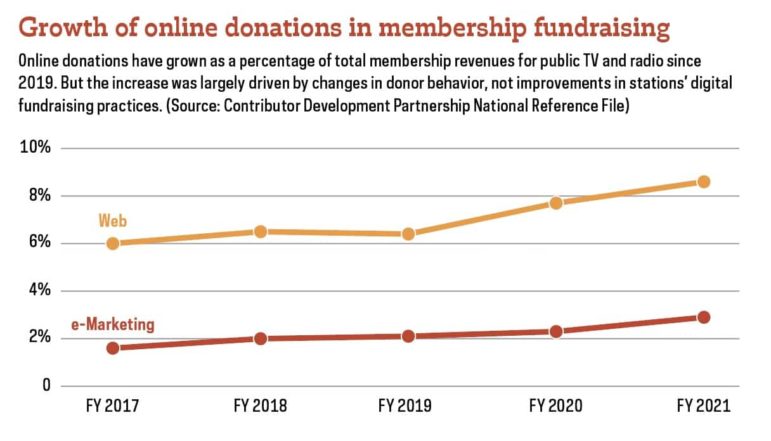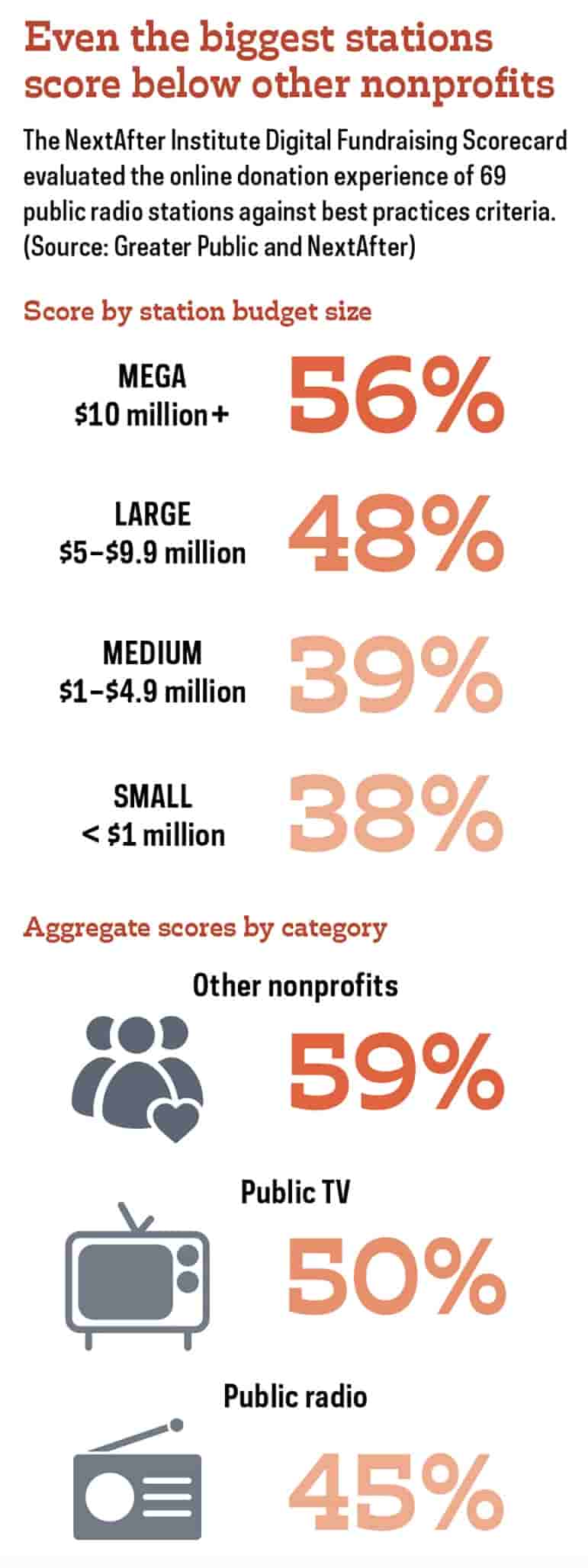At Greater Public, we connect individuals who are working on similar problems at different organizations within the public media system. We believe that when these folks share support and knowledge, we all gain insights about our industry as a whole because the challenges we face are rarely unique.

By applying this philosophy to research and testing of digital fundraising, we’ve concluded that public media’s digital fundraising practices need urgent attention and prioritization.
This discovery was confirmed by two groups of Greater Public members who began testing digital engagement this spring. One group focused on online donation forms and the other on email engagement. Both groups worked with advanced practitioners to guide their tests.
As the project progressed, we noticed a striking divide between the teams that were able to quickly implement new ideas and best practices with their online donation forms, and those that weren’t. While station size and limited team capacity can present challenges, size and resources weren’t the only predictors of which stations missed out on fundamental opportunities to raise more revenue online.
In 2021, with more than 20 years of experience accepting donations online, many stations lack the tools to make even basic changes to their online donation forms. The result is that thousands of dollars and long-term donor relationships are being lost at a time when audience engagement and listening is rapidly moving to online spaces.
This is happening even as most public media organizations raised more money from online and email sources than ever before. According to data from the Contributor Development Partnership’s National Reference File, 8.6% of membership revenue for public radio and television stations came from online donations in fiscal year 2021, up from 6.4% in FY19. Revenue generated from email barely grew over the same time period — from 2.1% in 2019 to 2.9% in 2021.

This growth was certainly driven by changes in behavior of donors during the pandemic. We have to consider how much more we would grow this number if we were to prioritize online fundraising and email marketing campaigns.
Public media has successfully prioritized digital revenue in other key strategic areas. New program development is happening nearly exclusively in the podcast space; successful shows are then adapted for terrestrial broadcast. Public media virtual events bring in up to six figures in sponsorship revenue. And yet, nearly every station has yet to make very basic fixes that are essential to improving their online giving experience.
So what is the holdup? Good question. Some problems are more complex: Online donation tools are failing in some cases, and constraints of license-holders can make it hard for station development teams to make changes. Other obstacles are so simple to overcome, it’s hard to understand why station leadership and development professionals are not doing more.
In spring 2020, we partnered with the NextAfter Institute for Online Fundraising to create a Digital Fundraising Scorecard on the online donation experience of public radio stations. We set out to make donations to 70 public radio stations, but the form for one of them literally didn’t work! For each of the 69 stations included in the study, we scored aspects of the online donation experience on how well they met best-practice criteria compiled by our research partner NextAfter.
Stations in the study met 41% of the online and email communications criteria identified as best practice, compared to 55% of nonprofits overall. Of the group of 69, just 10 stations included a strong value proposition, or reason to give, on their donation page. These statements are one of the most effective elements of messages that get individuals to complete their donation.

One reason why online donations still take a back seat to other fundraising channels is that on-air campaigns still drive revenue. This isn’t a bad thing. On-air fundraising distinguishes us from other nonprofits.
We know that listeners can increasingly avoid fund drives by streaming or listening to podcasts, but on-air drives still work and stations continue to meet their goals. Many listeners respond to drives by donating online. We’re missing valuable opportunities to follow up with them by email, a practice that’s shown to reliably increase donation amounts and retention.
And we have to be realistic: Potential Millennial and Gen Z donors have different expectations for responses to their gifts. We need more robust email files and workflows to communicate with them online.
Daily newsletters are one promising example of how to do this. Many stations launched daily newsletters during the pandemic, enabling them to target audiences whose typical habits were disrupted by the pandemic. With its Today So Far newsletter, KUOW in Seattle has reconnected with listeners in a new way. Since the newsletter launched in the fall of 2020, its subscriber base has grown organically; 42% of Today So Far subscribers are also members. The newsletter takes about two hours each day for one staff member to put together and has a 45% open rate.
Another reality is that some online donation platforms are, frankly, quite poor. They limit stations’ ability to use analytics to set and track goals, and they lack features that are now standard in most giving systems. In our Digital Fundraising Scorecard, NextAfter found that nearly all stations had a mobile-friendly experience (94%), but only 57% were fully mobile-responsive. Some online donation forms can’t accept coding from tools like Google Analytics; without the ability to implement tracking, it’s that much harder to understand donor conversion and donation completion rates. Stations clearly can make the move to new online donation and email providers, but the idea of converting to new systems is daunting and expensive for staff who are already stretched thin. Many organizations are left feeling stuck.
What can you do to break this logjam? First, set some concrete goals for yourself and your team. What percentage of revenue now comes from online donations? Use that to set a goal to increase that percentage over a six-, 12- and 18-month timeline.
If your online donation form isn’t doing the job, it’s time to make it a strategic priority to find a new one or improve what you have to the best of your ability. Look at the forms that other stations are using, and learn from other media organizations and nonprofits about how they developed theirs.
If your station already has forms and email series that work well, please share your copy and templates with smaller stations that are strapped for resources. In the spirit of providing a more vibrant community service for all, it would be a welcome and helpful move.
Finally, put yourself in the shoes of a donor and do some basic usability testing. You will be enlightened by the experience. Evaluate whether you can easily make a gift to your organization, on your phone, using one hand. Are you offering PayPal or Apple Pay as options to reduce friction in the transaction? After you complete the donation, look carefully at the messages you receive. Do you get a confirmation email or a series of emails helping to strengthen your connection to the station? How much time passed before you heard from your station? If it took several weeks and the first message was another solicitation, how did that make you feel as a donor?
In the 15 months since we concluded our initial digital fundraising study, the coronavirus triggered an unprecedented shift by American consumers to digital platforms for information, connection and transactions. This migration will never be reversed.

Many public media organizations improved their communications with listeners and members in response to the pandemic, the racial justice movement and the political upheaval of 2020. They threw out the rulebook on conventional notions of frequency and fundraising incentives to make themselves indispensable to audiences and a source of pride for members.
We still don’t know what the “new normal” will look like for public media workplaces, but elements of what that looks like for digital fundraising are clear. On-air campaigns continue, but for many stations on-air drives aren’t bringing in enough revenue. Effective digital engagement — coupled with swift, easy transactions and truly engaging incentives — will determine our success.
Melanie Coulson is the executive director for member station services at Greater Public, which supports public media organizations in fundraising that enables them to strengthen local service.
"time" - Google News
September 21, 2021 at 08:00PM
https://ift.tt/2VXcDmr
The time to prioritize digital revenues and engagement is now - Current
"time" - Google News
https://ift.tt/3f5iuuC

No comments:
Post a Comment